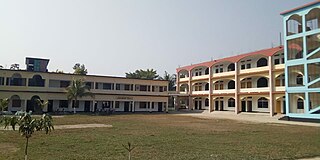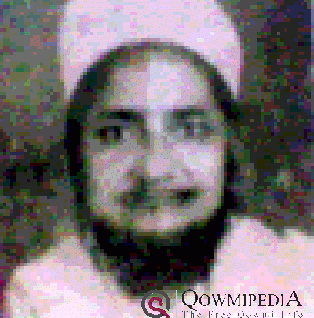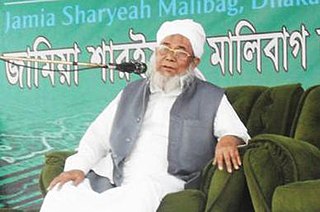
Al-Jāmiʿah Al-Islāmiyyah Patiya, better known simply as Patiya Madrasa and formerly known as Al-Madrasah Aḍ-Ḍamīriyyah Qāsim al-ʿUlūm, is a Qawmi Madrasah located in Patiya Upazila of Chittagong District, Bangladesh. It was established in 1938 by Azizul Haq under the direction of Zamiruddin Ahmad. It is also known as an International Islamic University. It has a role in the promotion of Islam in Bangladesh, inclusion of Qawmi Madrasas under one syllabus, providing modern and higher education for scholars.
Qawmi Madrasah is an adjective describing one of the two major madrasah educational categories in Bangladesh. The Qawmi madrasahs are not regulated by the Bangladesh Madrasah Education Board. As private charitable organizations, Qawmi madrasahs are supported almost exclusively by donation.

Bangladesh Madrasah Education Board or Alia Madrasah Education Board started its activity independently in 1979. With the passage of time in Bangladeshi madrasah education several amendments have come to pass. In 1978 humanities and science faculties were included at the Alim (عالِم) level. In 1980 Fazil (فاضل) degrees were granted the same standard of education as Higher Secondary School Certificate (HSC) degrees but this was changed in later years with Dakhil (داخل) level having the equivalency of Secondary School Certificate (SSC) since 1985, and Alim being considered as the HSC equivalent since 1987.

Mawlana Abdur Rahim was a Bangladeshi Islamic scholar, South Asian politician and the first promoter of Jamaat-e-Islami Bangladesh.
Abū al-Khayr Muḥammad Ayyūb ʿAlī al-Māturīdī, or simply Ayub Ali, was a Bangladeshi Islamic scholar, author and educationist. He was awarded the Ekushey Padak in 1976 by the Government of Bangladesh.

The West Bengal Board of Madrasah Education is the state government administered autonomous examining authority for affiliated and recognized madrasahs in West Bengal, India. Perhaps among the oldest post-secondary boards in India, it is the only madrasah board that is recognized by the Government of India. It is one of the parastatal organization of the Minority Affairs and Madrasah Education Department. The West Bengal Board of Madrasah Education is the West Bengal state government administered autonomous examining authority for the High Madrasah examination of West Bengal, India. It has come into force by the West Bengal Board of Madrasah Education Act-1994.

Government Madrasah-e-Alia is a government madrasa located in Bakshibazar, Dhaka, Bangladesh. Since its founding, the madrasah has been playing a significant role in imparting and spreading Islamic education.
Muhammad Abdullah was a Bangladeshi Islamic scholar and academic. He was a professor of Dhaka University and researcher.

Satpur Kamil Madrasah is an educational institution situated in Lamakazi at Bishwanath upazila, Sylhet. The madrasah is run under "Alia madrasah" curriculum up to kamil level. In 2017, Honours course was started besides regular curriculum under the affiliation of “Islamic Arabic University“,Dhaka. Among the 4.38 acres of total registered land only 1.65 acres are used as main academic area of the madrasah with current number of students being over 1500. A reconstruction project of the age-old educational building starting in 2016, has recently come to an end.
Sylhet Government Alia Madrasa is located in Chawhatta, Sylhet, Bangladesh. Founded in 1913, the madrasa currently has more than 650 students and 18 staff. The institution is located on the opposite side of Sylhet Government Women's College. It consists of 3 buildings, a dorm, a playground and 11,000-book-filled library.

Mushāhid Aḥmad Bāyampūrī was a late-twentieth century Bengali Islamic scholar, teacher, writer, orator and politician. Bayampuri served as a member of the National Assembly of Pakistan, the professor of Hadith studies at Sylhet Government Alia Madrasah, the principal of Darul Uloom Kanaighat and the president of the Eastern Sylhet Independent Religious Arabic Madrasah Education Board. His numerous works, which covered a range of disciplines in Islamic literature such as Sufism, Qur'anic exegesis and the political aspects of Islam, were written in the Arabic, Bengali and Urdu languages. Some of his books are part of syllabic studies under the Independent Religious Board of Education.
Badedeorail Fultali Kamil Madrasa is an Islamic educational institution located in Zakiganj, Sylhet District, Bangladesh. The madrasa was founded in 1920, and is now affiliated with the Islamic Arabic University for degree and honours programmes.
Majd ad-Dīn al-Madanī, also known as Madan Shāhjahānpūrī, was an 18th-century Indian Muslim theologian. He served as the first principal of the Calcutta Madrasa, the first Alia Madrasa of Bengal.
Abū al-ʿAzīz Muḥammad Ismāʿīl ʿAlī was a Bengali politician, teacher and activist of the Khilafat Movement. He wrote poetry in Urdu under the pen name of Ālam. His Diwan-i-Alam poem led to the Calcutta Alia Madrasa awarding him the title of Parrot of Bengal in 1910.

Qazi Mu'tasim Billah Bahar was a Bangladeshi Islamic scholar, teacher, author and politician. He was the principal of Jamia Shar'iyya Malibagh for over four decades, a former professor at the University of Dhaka and the founding principal of Jamia Islamia Darul Uloom Madania in Jatrabari, Dhaka. He has written many books and articles in the Bengali language and pioneered the introduction of a Bengali-medium among the Qawmi madrasas of Bangladesh.

Nesaruddin Ahmad was a Bengali Islamic scholar, spiritual reformer, educationist and writer. He was the main disciple of Furfura Sharif's Mohammad Abu Bakr Siddique in eastern Bengal. Ahmad was the inaugural Pir of Sarsina, having founded the Sarsina Darbar Sharif and Darussunnat Kamil Madrasa in 1915, one of the largest Islamic institutions in South Bengal and the first major alia madrasah after Calcutta. Ahmad was among the leading Islamic leaders in colonial Barisal, and his influence extended across Bengal. The Nesarabad Upazila of Bangladesh has been named after him.

Abū Naṣr Muḥammad Waḥīd, or simply Abu Nasr Waheed, was a Bengali Islamic scholar, educationist, author and politician. He is best known for his reformations to Islamic education in Bengal, and development of Arabic language education among Bengali Muslims. Wahid also served as the Education Minister of British Assam and a member of the Assam Legislative Assembly.
Baitush Sharaf Adarsha Kamil Madrasah ) is a religious educational institution and alia madrasah in Bangladesh. The madrasah was founded in 1982 by Shah Sufi Abdul Jabbar. The madrasah is located in Dhanialapara area under Double Mooring Thana of Chittagong city. This madrasah secured the first rank in the departmental level in the Dakhil examination held under Madrasa Education Board in 2019.

Buzurg Santoshpur Karamatia Fazil Madrasah is a madrasa located in Mithapukur, Rangpur District, Bangladesh.











